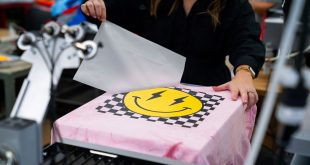
This month Danielle Park and Natalie Greetham of Madeira UK provide some sound advice on how to embroider onto knitwear and beanies.
Embroiderers currently snowed under with mountains of knitwear; from beanies to school uniform jumpers and everything in between will be well aware of the difficulties when embroidering onto knitwear.
From sinking stitches to holes forming in your fabric, even distortion of the design to puckering, knitwear can be tricky. However, thankfully these problems are easily avoided with some simple tips and helpful products.
Design distortion
A correctly digitised design is critical to the success of the embroidery, so always ensure that you tell your digitiser which material you will be embroidering onto as it really does make a big difference in how the design will be created, underlay stitches and pull compensation will be factored in to the digitising file making it much more stable.
If you are digitising in house, always select the correct fabric in your digitising software.
Puckering
The inherent properties of knitwear also mean that, if your fabric is over-stretched when framing or your design has too many stitches in it that puckering can occur.
Ensuring the garment is hooped with the correct amount of tension and is taught but not overtight, that your design has no unnecessary stitches or more than three layers of stitching will help avoid puckering.
Holes and ladders
Holes and ladders can form around your embroidery if your stitch density is too high, or if you are using the wrong needle.
Always ensure you use a ball point needle for embroidering onto knitwear so that during stitching the needle pushes the fibres of the fabric aside and slips through the structure of the knit, rather than piercing it.
Sinking stitches
Sinking stitches can be a real headache in deep pile fabrics such as knitwear or towelling and it can really compromise the finished look of your embroidery.
Using a topping film and framing it on top of your garment before embroidering can eliminate this difficulty. Water soluble toppings create a stable surface for embroidery, allowing it to sit comfortably and leaving a crisper finished look and then removed without a trace. However, if using a water soluble stabiliser remove as much of the stabiliser as possible by tearing it away, as large quantities can take on glue like properties when water is added which sticks to the knit and it can be difficult to remove.
With these simple steps we can all have fantastic embroideries on our knitwear this winter.
 Printwear & Promotion The Total Promotional Package
Printwear & Promotion The Total Promotional Package




